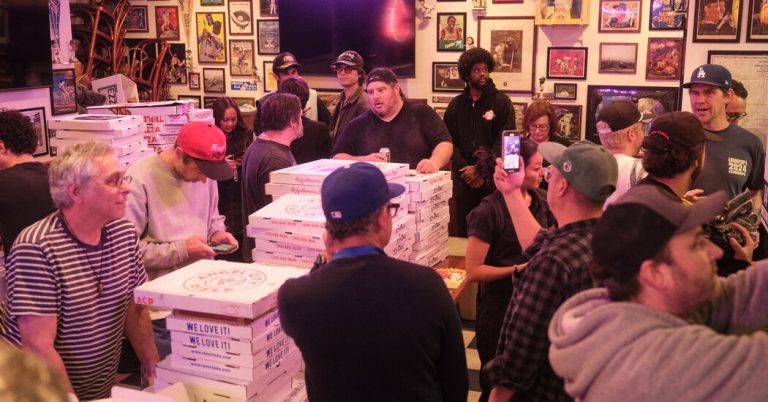A few weeks ago, I had dinner at LaSorted’s in Chinatown, eating pizza and drinking wine with my husband while our toddler nibbled on a crust and threw some salad leaves on the floor. When I walked in last Wednesday — as thousands of acres of Los Angeles were still burning — the dining room was almost unrecognizable, its wobbly tables reconfigured into a makeshift kitchen.
Pizzerias from all over the city crowded in, unpacking supplies and folding boxes. The line out the door looked like diners waiting for tables—blue Dodgers hats, oversized vintage buttons, insider T-shirts—but this was a crew of volunteer drivers signed up for Instagram. They waited for instructions from other volunteers who sorted hundreds of requests into a series of spreadsheets, text messages and DMs.
Thousands of firefighters are still working to contain the fires that have displaced tens of thousands of Angelenos. Every day, multiple times a day, a collective, grassroots mishmash of restaurant kitchens, trucks and makeshift catering businesses just like this one feed the city’s emergency workers and evacuees.
“It’s not something you train for or learn about,” said Tommy Brockert, the chef at LaSorted’s, who was evacuated but is now back home. “When things like this happen, people can do extraordinary things.”
Neighborhood restaurants aren’t exactly set up to respond to emergencies, but they just can’t help themselves. The best restaurant people tend to have a fundamental sense of hospitality, combined with the ability to deftly organize chaos.
No one has a greater sense of urgency to cook for people and take care of them, regardless of the logistical nightmares that may be involved. Day to day, this can mean dinner service is running smoothly. When disaster strikes, it means 200 people in five locations will have a hot dinner.
There are so many restaurants and restaurant workers helping out (many of them displaced) that the Los Angeles Times plotted them on a map. In her newsletter, writer Emily Wilson tracked the various resources they provided, along with fundraisers and appeals for volunteers and donations.
Khushbu Shah, a New York Times contributor who helped deliver some meals herself, wondered when all the independent restaurants that stepped in to help might find some financial support.
Most places that extend radical hospitality do so out of pocket or through an erratic stream of donations, and the truth is: No one can afford it. Meanwhile, city officials have said it will be another week before many people return to their homes.
Chefs I spoke to on the phone this week said employees were asking for hours they couldn’t give them — their dining rooms were too quiet. They said the bills are piling up. They said that a few years ago, they might have been able to handle a few rough days or even a rough week, but not now. Not after the compounding economic losses of the pandemic and the strikes. Soon, they said, the closings would begin.
However, I was surprised when the owners of Ruby Fruit, a lesbian bar in Silver Lake that I reviewed a few years ago, announced that they were closing—at least temporarily—because of the fires. It had become clear that even restaurants away from the flames and toxic smoke were not safe from this disaster.
I had canceled a few reservations in the first days of the fires or restaurants had called to cancel with me. Now it’s not a safety issue as much as an atmosphere issue: In so many neighborhoods, restaurants are open, air purifiers are working, but people still don’t go outside. When the whole town is mourning, you can’t escape your own sense of sadness.
I didn’t realize how much I needed to get out until I showered, washed my hair, and took some of my co-workers to dinner in East Hollywood. These reporters were in the field all day, all week, or couldn’t get away from their laptops.
I felt my body relax the second I held a menu in my hand, the second a server walked by and asked if he could get me something to drink, something to eat. “I needed this,” one of us said, every few minutes, as the plates filled the space between us. “I really, really needed this.”
“It” wasn’t a specific dining room or a dish to order, they were together in a Los Angeles restaurant while the fires were still burning. It was the sense of security, resilience and connection that the restaurants insisted on sharing, even as their staff weathered the crisis.
I couldn’t escape the sadness I felt – he dined with us, it was inevitable – but I couldn’t escape the gratitude either.




